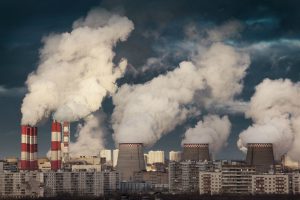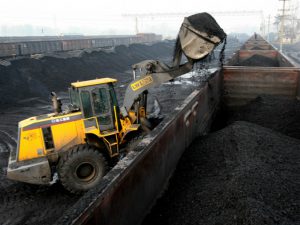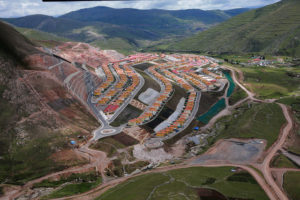China’s demand for fossil fuels, most notably coal, fell sharply in the first six months of this year, further evidence that moves to curb overcapacity and battle pollution are pushing China towards a much-vaunted peak in carbon emissions.
Data from China’s National Bureau of Statistics (NBS), the country’s top statistics agency, have long been closely-watched by those trying to work out whether China’s carbon emissions are about to level off.
This is even more the case in the first year of China’s 13th Five Year Plan, which runs from 2016 to 2020 and aims at “greener growth”.
However it is still far too early to tell whether the world’s largest source of greenhouse gases can engineer a steep long-term decline after hitting an emissions peak expected within the next decade.
The NBS data released today showed that coal output fell almost 10% from January to June, compared with the equivalent period in 2015, and a much faster fall compared with the first six months of last year.
Earlier this year, China’s central government banned the construction of new mines and ordered the rapid closure of older collieries in a bid to rein in chronic overcapacity in the sector and put the country on a path to a peak in carbon emissions by 2030 or before.
Weaker coal output was reflected in the latest figures on the amount of electricity generated from fossil fuels blamed most for climate change.
NBS data showed that thermal power generation (including coal and gas-fired electricity) fell by 3.1% year-on-year in the first half of 2016, while hydro, nuclear, wind and solar power generation went up by 13.5%, 25%, 14% and 28% respectively.
Moreover, the figures have again highlighted one of the major contradictions in the country’s climate and energy policy, as new coal-fired power capacity continues to get permits from provincial officials.
“China still has enough coal-fired projects in the pipeline to keep adding one coal-fired power plant per week until 2020, potentially resulting in a total of 400,000MW of excess capacity,” said Lauri Myllyvirta, a campaigner with Greenpeace East Asia.
Preferential access to the grid for large coal-fired plants, most of which are owned by China’s big five utilities, has long been blamed for crowding out wind, hydro and solar.
This has prompted central government to push for a fairer system so that China can increase the share of renewables in the energy mix, but so-called green dispatch is expected to be a slow, incremental process because of opposition from large power companies and the state grid.
Access for renewables actually worsened this year, prompting lawsuits from China’s huge wind energy industry and complaints from provinces that account for most of the country’s turbines.
Gas v renewables
Quite when China peaks its energy-related greenhouse gas emissions will depend to a large extent to which renewables, rather than gas, replace coal.
Natural gas accounts for around half of the carbon dioxide per unit of power generated compared with coal, and a huge increase in demand will offset some of the emissions savings from lower coal use, said Yang Fuqiang, senior adviser with the Natural Resource Defence Council.
“If the decline of coal this year can offset increased carbon emissions from the growth of natural gas and oil, we will be more confident to say that China has entered an emissions plateau,” he said in response to the NBS figures.
China will triple its gas demand to 510 billion cubic metres (bcm) by 2030, rising to 710 bcm by 2050, the China National Petroleum Corporation said in a rare long term energy outlook published this week.
Meanwhile, Yang adds that a peak in coal use will require any rebound in heavy industry to be moderate, particularly in industries such as steel, metals, cement, materials and chemicals, which account for almost half of China’s coal demand.
Structural shift
However the data released today does suggest structural changes in the Chinese economy, and decoupling energy demand from economic growth, are starting to take effect, one of the main intentions of the current FYP.
China’s power consumption was up 2.7% year-on-year in the first six months of 2016, compared with overall economic growth of 6.7% during the same period.
Electricity consumption by the manufacturing sector rose by only 0.5%, said the NBS, reflecting large-scale shutdowns of inefficient and unneeded capacity.
By contrast, electricity consumption by service industries – which the 2016-2020 plan aims to encourage – was up by 9.2%.
However, household electricity demand rose 7.7%, a figure that suggests China will have to do more in improving efficiency and the use of smart grids and meters to curb the impact of new gadgets and appliances.
Energy-hungry products such as refrigerators, air conditioners, cookers, tumble dryers and electronic gadgets have become increasingly affordable for China’s middle class, and at a time of mass migration to its cities, which further stokes up demand for electric products. It should be said, though, that per capita electricity use in China is just a fifth of that in the US for example.







